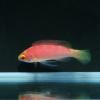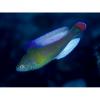-
Posts
16,553 -
Joined
-
Last visited
-
Days Won
29
Content Type
Profiles
Forums
Gallery
Everything posted by yikai
-

The world's fairy wrasses of the genus Cirrhilabrus
yikai replied to yikai's topic in FOWLR (Fish-only with Live-rock)
Cirrhilabrus sp 2. KwaZulu fairy wrasse. Known only from South Africa, and shows some similarity to Cirrhilabrus morrisoni. -

The world's fairy wrasses of the genus Cirrhilabrus
yikai replied to yikai's topic in FOWLR (Fish-only with Live-rock)
Cirrhilabrus rubriventralis Social fairy wrasse. Red Sea and western Indian Ocean. Part of the "rubriventralis-complex". Similar to Cirrhilabrus joanallenae in the eastern Indian Ocean. Males have long dorsal fin rays and long ventral fins which are red. Females are orange with blue stripes and look very similar to other species in this complex. -

The world's fairy wrasses of the genus Cirrhilabrus
yikai replied to yikai's topic in FOWLR (Fish-only with Live-rock)
Cirrhilabrus walshi Walsh's fairy wrasse. Known only from the Coral Sea to American Samoa, from a few specimens collected in 37-46m. Very similar to C. condei but with yellow dorsal fin and a more slender shape. -

The world's fairy wrasses of the genus Cirrhilabrus
yikai replied to yikai's topic in FOWLR (Fish-only with Live-rock)
Cirrhilabrus sp. 1 Nachkyi fairy wrasse. Known from Tonga. Very similar to Cirrhilabrus bathyphilus, but have an elongated first dorsal spine with differently coloured and shaped dorsal fin. -

The world's fairy wrasses of the genus Cirrhilabrus
yikai replied to yikai's topic in FOWLR (Fish-only with Live-rock)
Cirrhilabrus bathyphilus Hooded fairy wrasse, Deep-water fairy wrasse, Rosy-fin fairy wrasse. Three variants of this species occur. Coral Sea and Australian variants are red throughout with rosy-pink fins. Variants from Souther Vanuatu (Tanna Island) have a distinct red head with orange-yellow body. A red streak continues from the head to the caudal penducle. Northern Vanuatu variants (Efate Island) have a distinct red head and a yellow-orange body. The two colours are separated and distinct. All variants have rosy pink fins that are very beautiful. Shape of dorsal fin is very unique, with the front part being very square and higher than the back portion. Dorsal fin starts futhur down the head. First pic of an Australian male, 2nd pic of a southern Vanuatuan male, and the last pic of a northern Vanuatuan male. -

The world's fairy wrasses of the genus Cirrhilabrus
yikai replied to yikai's topic in FOWLR (Fish-only with Live-rock)
Cirrhilabrus cf lanceolatus Pintail fairy wrasse. Izu region to the Ryuku Islands, and Cebu Philippines. Males are beautifully and exquisitely coloured with a long lanceolate tail which resembles Cirrhilabrus lanceolatus. Undescribed species but will be described soon by Dr. Senou. -

The world's fairy wrasses of the genus Cirrhilabrus
yikai replied to yikai's topic in FOWLR (Fish-only with Live-rock)
Cirrhilabrus claire Claire's fairy wrasse Known only from the Cook islands. Information N/A. The only photo available is of a holotype. Gender of holotype uncertain. Rarest fairy wrasse in the world with no proper information and proper pictures of it yet. -

The world's fairy wrasses of the genus Cirrhilabrus
yikai replied to yikai's topic in FOWLR (Fish-only with Live-rock)
Cirrhilabrus earlei Earl's fairy wrasse. Known only form Palau. A deepwater species. It has distinctive striped patterns and adults usually have a pointed caudal fin. Males have blue cheeks when flashing. A gorgeous but extremely expensive species. 1st and 2nd pic shows terminal male phased specimens, 3rd pic shows a female and last pic shows a flashing male. -

The world's fairy wrasses of the genus Cirrhilabrus
yikai replied to yikai's topic in FOWLR (Fish-only with Live-rock)
Cirrhilabrus lineatus Lavender fairy wrasse, Lineatus fairy wrasse. Great Barrier Reef and Coral Sea. Males are easily identified by their colouration. When displaying, the tail turns bright red and pectoral fins turn orange. Dorsal and anal fins turn white. Females are pink with blue spots and lines on the body. Juveniles are pink with yellow eyes. A highly sought after species. First pic of a terminal male specimen, 2nd pic of a terminal male displaying and 3rd pic shows ayoung male. -

The world's fairy wrasses of the genus Cirrhilabrus
yikai replied to yikai's topic in FOWLR (Fish-only with Live-rock)
Cirrhilabrus pylei Pyle's fairy wrasse. Western Pacific, Bali, PNG and Philippines. Very long ventral fins and males from the Western pacific have a blue margin on the tail. Specimens from Philippines have black tail margins and a large black spot on the 2/3 length of the dorsal fin. A very aggressive species. first pic of a female, 2nd pic of a Vanuatuan Pyle's fairy wrasse, 3rd pic of a Vanuatuan Pyle's fairy wrasse in nuptial colouration and the last pic, of a Cebuan Pyle's fairy wrasse (Cebu Variant). -

The world's fairy wrasses of the genus Cirrhilabrus
yikai replied to yikai's topic in FOWLR (Fish-only with Live-rock)
Cirrhilabrus rubrimarginatus Red margin fairy wrasse, Pink margin fairy wrasse. West Pacific from southern Japan to Indonesia and PNG. Large males have red margins on dorsal and tail fins. Pacific variation i.e Fijian specimens differ from the duller Indonesian specimens. Fijian specimens have long black ventral fins and a dark chest with numerous yellow spots. A bright pink saddle is also present on the Fijian variants. 1st pic of a female, 2nd pic of an Indonesian specimen, 3rd pic of a Fijian specimen and the last pic, a displaying male. -

The world's fairy wrasses of the genus Cirrhilabrus
yikai replied to yikai's topic in FOWLR (Fish-only with Live-rock)
Cirrhilabrus blatteus Red-sea fairy wrasse. Endemic to only the Red Sea. Identified by the long tail with yellow. Body has purple lines. Extremely rare and never caught for the aquarium trade before. -

The world's fairy wrasses of the genus Cirrhilabrus
yikai replied to yikai's topic in FOWLR (Fish-only with Live-rock)
Cirrhilabrus sanguineus Blood-stained fairy wrasse. Mauritian endemic. Deep water species found on rubble slopes at 40-60m Males identified by the striking red bar. When displaying, ventral fins turn bright yellow. An interesting story behind the discovery of this species. "C. sanguineus was named by Cornic in 1987 in his small book, not a paper, and he did not examine any ! Jack Randall was very angry because Cornic borrowed Jack's photos before he started to write a book. Then he named only with several sentences in the book. A new fish was once named it cannot be changed !" Dr. Hiroyuki Tanaka First pic of an unexcited male, 2nd pic of a male displaying nuptial colouration. -

The world's fairy wrasses of the genus Cirrhilabrus
yikai replied to yikai's topic in FOWLR (Fish-only with Live-rock)
Cirrhilabrus rhomboidalis Rhomboid fairy wrasse, Diamond tail fairy wrasse. Known only from Marshall Islands and Palau. Males are gold and purple with long diamond shaped tail. When displaying, the fish turns entirely golden with a purple saddle on the mid portion of the body. first pic of a male, 2nd pic of a group of females in the wild, and the 3rd pic, a flashing male. -

The world's fairy wrasses of the genus Cirrhilabrus
yikai replied to yikai's topic in FOWLR (Fish-only with Live-rock)
Cirrhilabrus adornatus Debelius fairy wrasse. Known only from the islands off the west coast of Sumatra. It appears to be closely related to Cirrhilabrus flavidorsalis and females look identical. Some males have an almost all white body, with red heads. -

OMG! Look at these hybrids and rare fishes!
yikai replied to Digiman's topic in FOWLR (Fish-only with Live-rock)
callogobius sp. -

The world's fairy wrasses of the genus Cirrhilabrus
yikai replied to yikai's topic in FOWLR (Fish-only with Live-rock)
Cirrhilabrus lubbocki Lubbock's fairy wrasse. Philippines to Flores seas. Coastal and inner reefs with low, rich coral and algae coverage. Very variable in colour from pinkish to bright red or purple and dorsal fin bright yellow in adults. Females are virtually identical and indistinguishable from other females of other species. A different variant of the Lubbock's fairy wrasse exist in which it is mostly white with 2 black horizontal stripes. -

The world's fairy wrasses of the genus Cirrhilabrus
yikai replied to yikai's topic in FOWLR (Fish-only with Live-rock)
Cirrhilabrus flavidorsalis Yellow-fin fairy wrasse. Philippine to northern Indonesia and Flores seas. Males are highly variable in colour with dorsal fin colours from yellow to red to blue. Females look virtually identical to some other fairy wrasses. -

The world's fairy wrasses of the genus Cirrhilabrus
yikai replied to yikai's topic in FOWLR (Fish-only with Live-rock)
Cirrhilabrus rubrisquamis Rosy-scale fairy wrasse. Maldives, Chagos Archielago and Sri Lanka region. During displaying of nuptial colouration, whole body turns white and red is reduced to head area. first picture of a flashing male, 2nd picture of an unexcited male. -

The world's fairy wrasses of the genus Cirrhilabrus
yikai replied to yikai's topic in FOWLR (Fish-only with Live-rock)
Cirrhilabrus filamentosus Whip-fin fairy wrasse. Southern Indonesian waters, from Java and Timor seas. Occurs on deep muddy coastal slopes and is primarily known from deep water trawls. Very aggressive. First pic of an unexcited male, 2nd pic of a male flashing. -

The world's fairy wrasses of the genus Cirrhilabrus
yikai replied to yikai's topic in FOWLR (Fish-only with Live-rock)
Cirrhilabrus tonozukai Tono's fairy wrasse. Eastern Sulawesi: Lembeh Straits to the Banggai Islands and Palau. Females resemble other species and are virtually indistinguishable. Males have a dorsal filament with red anal fins. Similar in shape to Cirrhilabrus filamentosus. -

The world's fairy wrasses of the genus Cirrhilabrus
yikai replied to yikai's topic in FOWLR (Fish-only with Live-rock)
Cirrhilabrus rubripinnis Red-fin fairy wrasse. Philippines to northern Indonesia. Lives on open rubble substrates with short algae and sparse coral or sponge growth at 30-40m. Occurs in small groups, each with a single male. Males have large dorsal and anal fins which are bright red and erected during display. Ventral fins with long filaments. -

The world's fairy wrasses of the genus Cirrhilabrus
yikai replied to yikai's topic in FOWLR (Fish-only with Live-rock)
Cirrhilabrus cenderawasih Cenderawasih's fairy wrasse. West Papua. Closely related to C. walindi. Males have a bright yellow blotch on it's sides. Females virtually identical and indistinguishable from some other species. -

The world's fairy wrasses of the genus Cirrhilabrus
yikai replied to yikai's topic in FOWLR (Fish-only with Live-rock)
Cirrhilabrus walindi Walindi fairy wrasse. Eastern New Guinea and Solomon Islands. Occur on rubble slopes with rich invertebrate-growth. Usually seen in small groups of mostly females and males swim loosely between them or higher above the substrate. Reported to dwell as shallow as 10m in Kimbe Bay but occur mostly at 40-50m depth. Males readily identified by the black blotches and lunate tail. Females are pink and virtually identical to some other female fairy wrasses. First pic of a male, 2nd pic of a male/female pair. -

The world's fairy wrasses of the genus Cirrhilabrus
yikai replied to yikai's topic in FOWLR (Fish-only with Live-rock)
Cirrhilabrus marjorie Marjorie's fairy wrasse. Coral Sea, Fiji region. Males are readily identified by the distinctive colour pattern. Red dorsally and stark white ventrally. Dorsal fin have a black margin. In deeper waters, the brilliant red colouration may appear blue-black. Females look very similar to other species including Cirrhilabrus walindi, C. flavidorsalis, C. cenderawasih, C.tonozukai, C. adornatus, in being plain pink with a black spot on the caudal penducle. A gorgeous gorgeous species. Named after Bruce Carlson's wife, Marj. Pics of 2 males.




















































